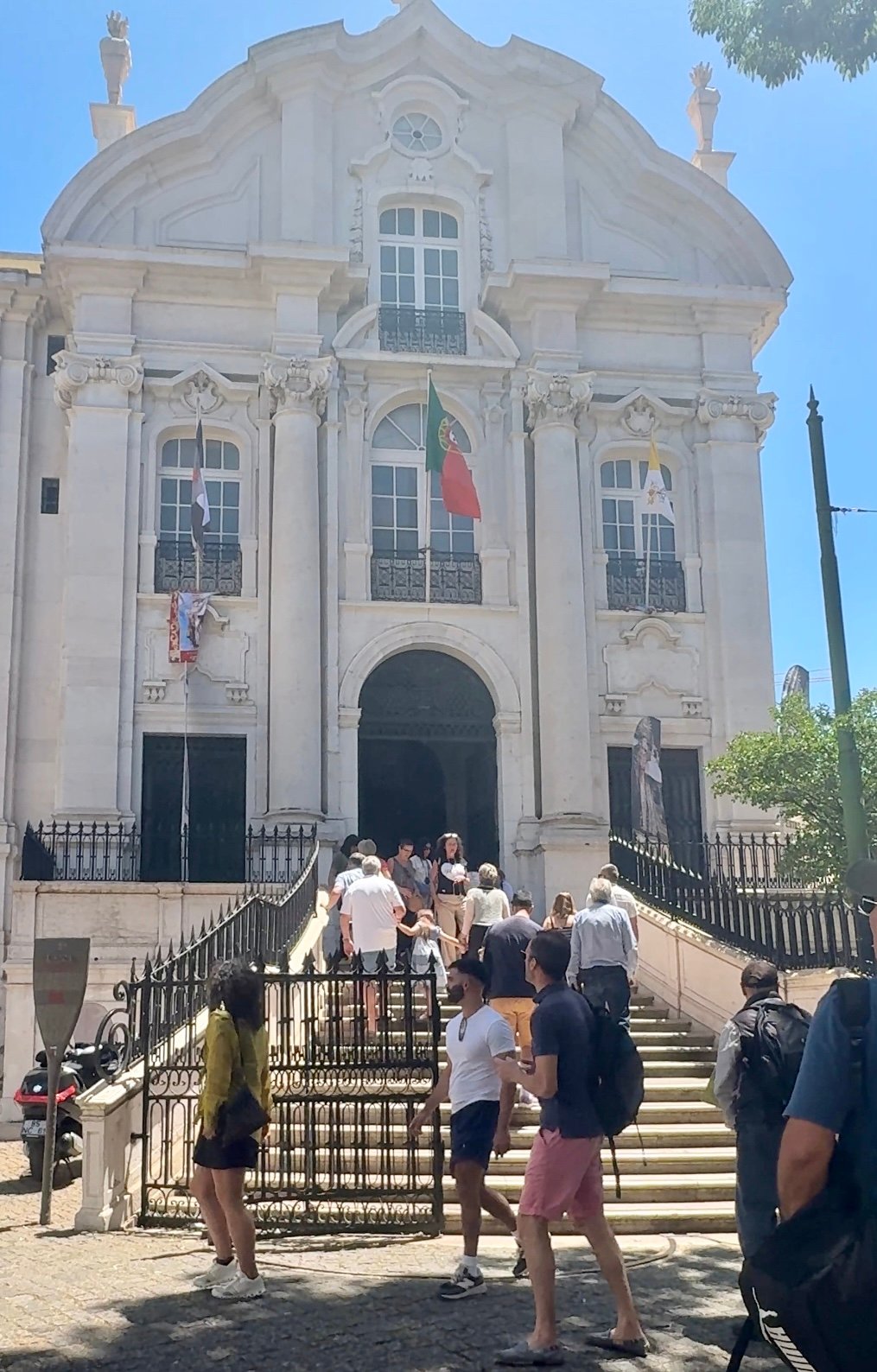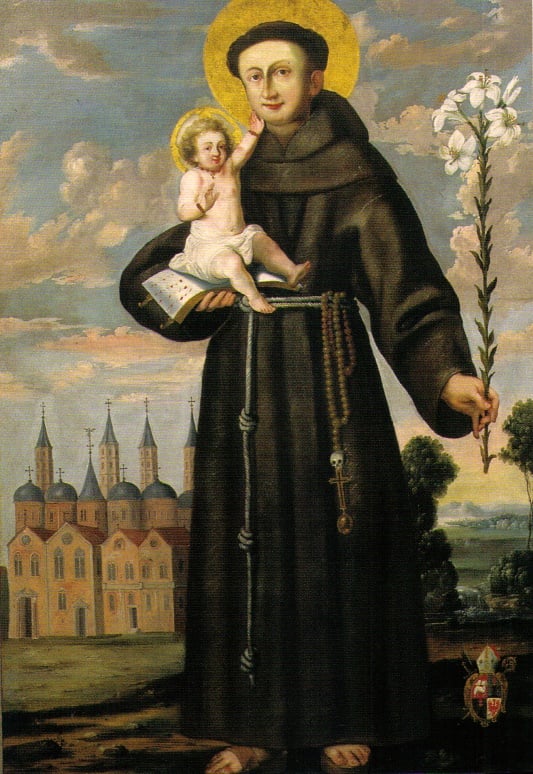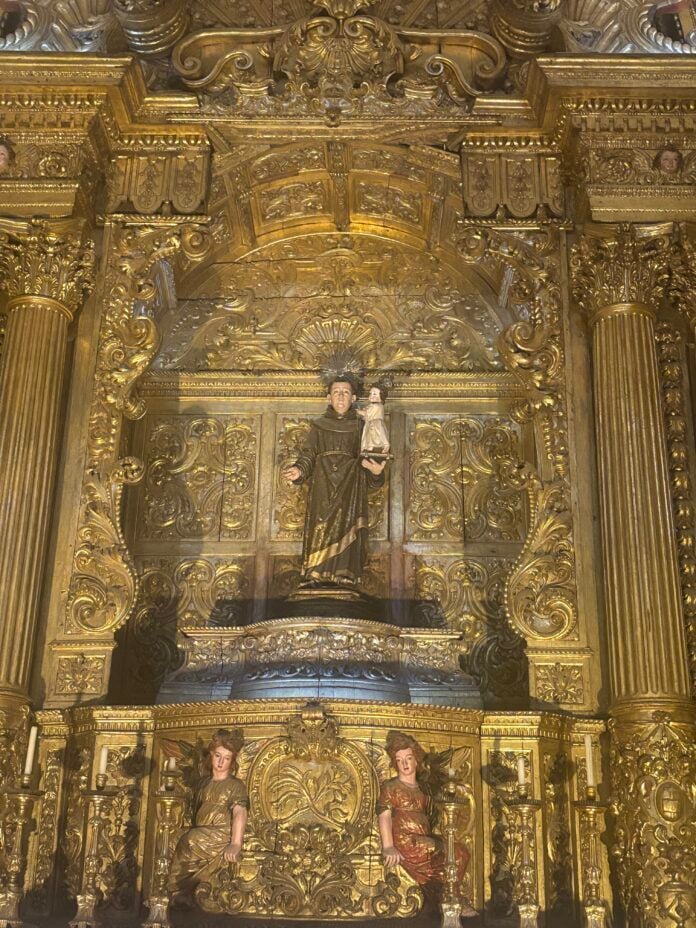The Festival of Santo António on June 12 transforms Lisbon into a non-stop party of music, dance, romance, and religious devotion. But there is fascinating story behind the colorful marches, grilled sardines, and the group weddings parading through the streets – a saint who captured the hearts of Lisboners centuries ago and continues to be celebrated around the world.
Santo António, known internationally as Saint Anthony of Padua, holds a special place in Lisbon’s heart. His influence permeates daily life from matters of the heart to lost possessions. This makes him one of the most approachable and beloved saints in the Catholic faith. But who was Santo António and what makes him so beloved? Here are seven interesting facts about this remarkable figure who has become synonymous with Lisbon itself.
1. Santo António is actually not the official patron saint of Lisbon!
Perhaps the most surprising fact about Santo António’s role in Lisbon is that he technically shares his patron saint status under somewhat controversial circumstances. The official patron saint of Lisbon, according to the Catholic Church, is actually São Vicente (Saint Vincent). His statue stands proudly at Portas do Sol in Alfama, where he holds the symbol of the city – a ship crewed by two crows.
Why does Santo António outshine the official patron saint, São Vicente? Blame it on the weather! São Vicente’s feast day falls on January 22nd, which is hardly ideal weather for the outdoor partying that Lisboetas adore. Santo António’s feast day, June 13th, arrives at the perfect time of year for firing up the sardine grill and dancing in the streets!
This reveals something charming about Portuguese culture: while deeply respectful of tradition and faith, the people aren’t above making practical adjustments to be able come together as a community and celebrate. Santo António was essentially adopted by popular demand!
2. He was born right in the heart of Lisbon.
Unlike many patron saints who are adopted by cities with which they had little connection, Santo António has authentic Lisbon roots that run deep. Born in 1195, he entered the world just steps away from where the Sé Cathedral stands today, in the very heart of what was then a much smaller medieval city. The church that now bears his name, Igreja de Santo António, sits was essentially built right on top of his birthplace.
This really explains Lisbon’s devotion to Santo António. He is genuinely one of Lisbon’s own, a Lisbon boy who grew up to achieve international recognition for his holiness and wisdom. The fact that visitors can walk the same narrow streets where the young António once played gives his cult of devotion an intimacy that’s hard to replicate with imported saints.
The neighborhood around the Sé where Santo António was born retains much of its medieval character today. The winding streets, ancient buildings, and steep hillsides create an atmosphere where it’s easy to imagine life in the 12th century. During the June festivities, these same streets come alive with decorations and music celebrating Lisbon’s most famous son.

3. He was declared a saint less than a year after his death.
While Santo António was born and raised in Lisbon, his path to sainthood and international recognition came from Italy, specifically in the city of Padua.
After becoming a Franciscan friar, Santo António embarked on an extraordinary journey that took him through Morocco and France before ultimately leading him to Italy. His travels through Morocco connected him to the broader Mediterranean world and exposed him to different cultures and religious perspectives. This international experience shaped his worldview and contributed to his effectiveness as a teacher and preacher.
It was in Padua where Santo António truly flourished as a theologian and teacher. He taught at several European universities and earned recognition for his profound understanding of theology and his exceptional ability to communicate complex religious concepts to a variety of audiences – Santo António was truly a man of the people. His reputation as a scholar and holy man spread throughout Italy and beyond and established him as one of the most important religious figures of his era.
His Italian period also contributed to his rapid canonization. He was declared a saint less than a year after his death, an almost unprecedented speed that testified to his widespread reputation for holiness and miracle-working. This quick recognition by the Catholic Church helped establish his cult of devotion across Europe.
4. He’s the ultimate matchmaker saint.
Perhaps no aspect of Santo António’s reputation is more beloved in Portugal than his role as the matchmaker saint. This designation has transformed him into something of a celestial cupid and made him responsible for bringing couples together and ensuring happy marriages. The tradition is so strong that it has shaped one of Lisbon’s most distinctive and heartwarming traditions.
Since 1958, Lisbon has hosted the Casamentos de Santo António (Santo António’s Weddings), a remarkable event that takes place annually on June 12th, the day before the saint’s feast day. This mass wedding ceremony, where the civil ceremony happens in the Igreja de Santo António, allows couples with financial difficulties to celebrate their marriage with the city’s sponsorship. The Sé Cathedral serves as the venue for the religious part of the ceremony, and the couples feel special on their wedding day alongside multiple couples saying their vows simultaneously.
The sight of many couples in wedding attire, surrounded by family and friends, embodies the spirit of Santo António’s generosity. The event is also televised and allows all of Portugal to participate in these moments of happiness and hope. Throughout the year, young people pray to Santo António for help in finding love, and many credit him with bringing them together with their future spouses. Couples often visit his church to ask for his blessing on their relationships, and his feast day is considered an especially auspicious time for proposals and declarations of love.

5. He’s the go-to saint for lost things (and lost People and lost souls).
As if Santo António wasn’t already doing enough, he’s also internationally recognized as the patron saint of lost items, lost people, and lost souls. This makes him one of the most practically useful saints in the Catholic calendar, someone you can turn to whether you’ve misplaced your keys or lost your way in life. It also helps to make him immediately relatable for modern people. Countless Catholics around the world have whispered quick prayers to Santo António when searching for missing objects: “Santo António, Santo António, look around, something’s lost and must be found.” This simple prayer has been repeated in dozens of languages across continents.
As the patron of lost people, he’s also invoked by families searching for missing relatives, by travelers who have lost their way, and by anyone feeling disconnected from their community or purpose.
The “lost souls” aspect of his patronage speaks to his role as a spiritual guide for those struggling with faith, doubt, or moral confusion. His own journey from Portugal to Morocco to France to Italy demonstrates his understanding of spiritual searching and the winding paths that lead to enlightenment and peace.

6. His popularity spans continents and centuries.
Santo António’s influence extends far beyond the borders of Portugal, as we have already mentioned. But just how far?
It is estimated that there more than 65 municipalities, cities, or towns named after the saint, along with seven rivers, seven waterfalls, five mountains, two islands, and two lagoons. In Brazil alone, there are 38 municipalities with Santo António in their names. In the state of São Paulo, one researcher identified, more than ten waterways, two mountains, and one lagoon named after the beloved saint.
And that’s not even counting the churches! A 1981 survey by the Catholic Church in Brazil revealed 158 churches dedicated to St. António’s devotion in just the region from Santa Catarina to Espírito Santo including São Paulo.
This widespread popularity speaks to Santo António’s accessibility and relevance across different cultures and social contexts. People truly consider Santo António a saint who understands their daily struggles and aspirations and a saint for everyday people dealing with ordinary challenges.
A Saint for Modern Times
Unlike some saints whose stories seem distant and otherworldly, Santo António addresses the everyday concerns that continue to occupy our thoughts: love, loss, community, and the search for meaning.
His story embodies the Portuguese spirit in many ways. It is practical yet romantic, deeply traditional yet adaptable to changing times, locally rooted yet internationally minded. The fact that a 12th-century friar continues to inspire mass celebrations, televised weddings, and neighborhood competitions in the 21st century speaks to something enduring in his appeal.
In Santo António, Lisbon adopted a patron saint that is reflection of its own character: generous, romantic, welcoming, and eternally optimistic about the power of human connection.


